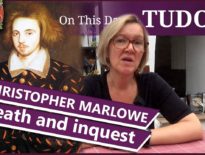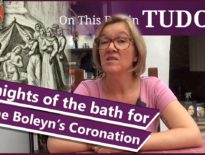On this day in Tudor history, 31st May 1529, a special legatine court opened at Blackfriars in London. The court’s purpose was to hear the case for an annulment of Henry VIII’s marriage to Catherine of Aragon, and it was presided over by papal legate Cardinal Lorenzo Campeggio and Cardinal Thomas Wolsey.
Find out about the context of this court, what happened at the court and what happened next in today's talk.
Catherine’s speech:
Also on this day in Tudor history, 31st May 1533, Anne Boleyn’s coronation procession took place. Find out more about this huge procession, which included including lavish pageants, orations, music, and wine flowing in the conduits and in fountains, in last year’s video:
Also on this day in history:
- 1443 - Lady Margaret Beaufort, Countess of Richmond and Derby, and matriarch of the Tudor dynasty, was born at Bletsoe Castle in Bedfordshire.
- 1516 - Birth of John Harpsfield, religious writer and Catholic priest. He was born in the parish of St Mary Magdalen, Old Fish Street, London. His brother was Nicholas Harpsfield, later Archdeacon of Canterbury. Nine of his sermons were published in Bonner's 1555 "Homilies", and he was a well known spokesman for Catholicism, even preaching before Philip of Spain.
- 1545 – Burial of Agnes Howard (née Tilney), dowager Duchess of Norfolk, at Thetford Abbey. She was the widow of Thomas Howard, 2nd Duke of Norfolk.
- 1578 – Sir Martin Frobisher set sail with his fleet from Harwich, England to Frobisher Bay, Canada. By 31st August, he and his men had mined 1370 tons of ore, which was loaded onto the ships to take back to England. Unfortunately, no gold or other precious metal was found in the ore.
- 1589 – Death of Sir Walter Mildmay, administrator and founder of Emmanuel College, Cambridge, at his home in Smithfield.
- 1590 – Birth of Frances Howard, Countess of Somerset, daughter of Thomas Howard, 1st Earl of Suffolk, and his second wife, Katherine Knyvett. Frances was married twice, first to Robert Devereux, 3rd Earl of Essex, and then to Robert Carr, Viscount Rochester and Earl of Somerset. Her first marriage was annulled because Devereux was unable to consummate the marriage.
- 1596 – Death of John Lesley, Bishop of Ross, historian and conspirator. He was a supporter of Mary, Queen of Scots and published "A defence of the honour of the right high, mightye and noble Princess Marie, queene of Scotland", a treatise defending Mary against charges that she was involved in Lord Darnley's murder.
- 1601 – Death of Katherine Brettergh (née Bruen), 'exemplar of godly life'. Her biographer, Steve Hindle, writes of her deathbed crisis of faith "during which she raged against God's unmercifulness and threw her Bible repeatedly to the floor", and how "Her agonies formed the centrepiece of a polemical account of her embattled life appended to the two sermons preached by William Harrison and William Leigh at her funeral", and which were published. Her crisis, they said, was a struggle between God and Satan for her soul.
Transcript:
On this day in Tudor history, 31st May 1529, a special legatine court opened at Blackfriars in London.
The court’s purpose was to hear the case for an annulment of Henry VIII’s first marriage, his marriage to Catherine of Aragon, to whom he’d been married for nearly 20 years by this point. The court was presided over by papal legate Cardinal Lorenzo Campeggio and Cardinal Thomas Wolsey.
In early 1528 Cardinal Thomas Wolsey, Henry VIII’s Lord Chancellor and chief advisor, had written to Pope Clement VII outlining Henry VIII’s demand that the case for an annulment of his marriage to Catherine of Aragon be decided in England by Wolsey and a visiting papal legate, who would act with the full authority of the Pope. On the 13th April 1528, a papal bull had empowered Cardinal Wolsey as the Pope’s viceregent “to take cognisance of all matters concerning the King’s divorce” and Cardinal Campeggio had been made papal legate in June 1528 in preparation for hearing the divorce case.
Campeggio landed at Dover on the Kent coast on 29th September 1528, and on 8th December 1528, he arrived in London. However, at this point, as historian Eric Ives explained, his “powers were not complete” which necessitated “further wearisome and unsatisfactory negotiation with the papal Curia.” This lack of authority was actually a papal stalling tactic.
Things were made worse for Henry VIII and Wolsey when Catherine of Aragon produced Pope Julius II’s dispensation for her to marry Henry. This put a spanner in the works and caused delays with the case. In the meantime, Campeggio met with Catherine and advised her to join a convent, something which would allow the marriage to be annulled easily. But Catherine believed that she was Henry’s true wife and queen, and she would not agree to taking the veil. Henry VIII and Wolsey then played dirty, threatening Catherine with separation from her daughter, Mary, if she would not obey the King. Instead of submitting to the king, Catherine fought back by appealing to Rome against the authority of Wolsey and Campeggio to try the case at a Legatine Court. She had the support of the people and men like John Fisher, Bishop of Rochester, Archbishop William Warham and Cuthbert Tunstall, Bishop of London.
Campeggio could only stall for so long and formal proceedings finally began on this day in 1529 at Blackfriars. On the 21st June, Henry and Catherine appeared at the court, and Catherine gave an impassioned speech at the court, while kneeling at her husband’s feet and appealing directly to him. I’ll give you a link to find out more about her speech, but in it she said that she’d been his true wife for twenty years and had given him diverse children, although God had called them out of this world, and she claimed that when Henry had taken her as his wife that she had been a true maid, “without touch of man”. After stealing the show completely, she left the court, leaving the king to put forward his doubts about the marriage.
Henry VIII had high hopes for this court case, but it came to nothing when the court was adjourned in July 1529 for a summer recess, never to meet again. It took until May 1533, following the break with Rome, for the marriage to be formally annulled.



Leave a Reply